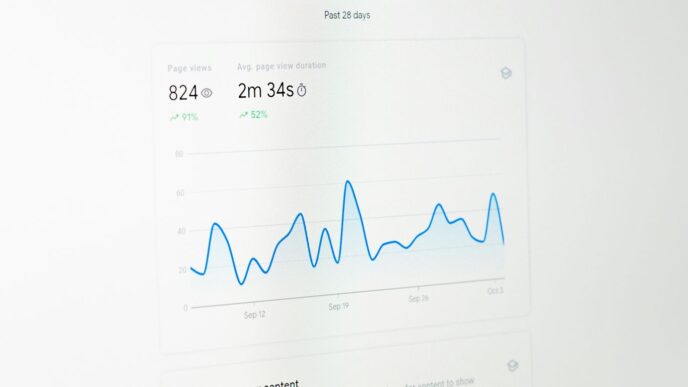It’s easy to get caught up in the latest gadgets and software, thinking tech is all about circuits and code. But if you stop and think about it, every single piece of technology, from your phone to the internet, started with a person. Someone had an idea, a need, or a problem they wanted to solve. That’s why, at its heart, all tech is human. This article explores how our feelings, our struggles, and our values are what truly drive innovation and what we should keep at the forefront as we build the future.
Key Takeaways
- Technology is born from human needs and ideas; therefore, all tech is human in its origin and purpose.
- Genuine creativity stems from human emotions, personal experiences, and unique sparks that AI cannot replicate.
- Learning and understanding require effort and challenge, which can be diminished by over-reliance on tools like generative AI.
- Designing technology should prioritize human values, community, and shared experiences over purely commercial interests.
- The future of technology lies in augmenting human capabilities through collaboration, not replacing the human element.
The Human Core Of All Tech
It’s easy to get caught up in the shiny newness of technology. We talk about processors, algorithms, and the latest software updates. But if you stop and think about it, all of this stuff, every single bit of it, comes from people. It’s built by people, for people, and it’s meant to be used by people. So, really, the whole tech world is just a reflection of us, isn’t it?
Understanding The Human Soul In The Digital Age
We’re living in a time where so much of our lives happens online. We connect, we work, we learn, and we even entertain ourselves through screens. This digital shift has made us wonder what it means to be human when so much of our experience is mediated by technology. Are we losing something, or is this just a new way of being human? It’s a big question, and honestly, there aren’t easy answers. Some folks worry that we’re becoming less connected to each other in real life, or that our attention spans are shrinking because of constant notifications. Others see it as just another tool, like the printing press or the telephone, that changes how we interact but doesn’t change our core humanity. It’s about how we choose to use these tools, and what we prioritize.
Humanist Thinking At The Center Of Technological Conversations
For a long time, the conversation around technology has been dominated by engineers and business folks. They focus on what a piece of tech can do and how much money it can make. But what if we put people, their feelings, and their well-being at the heart of these discussions from the start? This is where humanist thinking comes in. It’s about asking why we’re building something and who it will affect, not just how it works. For example, when designing new apps or systems, we should be thinking about how they impact our relationships, our sense of community, and our mental health. It’s about making sure technology serves us, rather than the other way around. This approach is key to human-centered design, making sure technology actually helps people live better lives.
Are We Becoming Tech People?
This is a question that pops up a lot. Are we so immersed in technology that we’re starting to think and act like machines? Think about how we interact with AI assistants or how we expect instant responses. It’s true that technology has changed our habits. We might find ourselves less patient, or we might rely on quick digital answers instead of thinking things through. A study showed that students who used AI tools like ChatGPT for essays remembered much less of what they wrote compared to those who did the work themselves. It seems that when things get too easy, our brains don’t engage as much. We need a bit of a challenge to really learn and own our knowledge. So, while we’re not turning into robots, we are definitely adapting to a tech-filled world, and it’s worth paying attention to how that changes us.
Creativity’s Uniquely Human Spark
It’s easy to get caught up in what machines can do these days. They can whip up images, write text, and even compose music that sounds pretty convincing. But when we talk about real creativity, the kind that sticks with you, it’s a whole different ballgame. That special something comes from our messy, emotional, and deeply personal human experience.
The Irreplaceable Element In Art And Innovation
Think about your favorite song or a painting that just hits you right. Chances are, it’s not just technically perfect; it’s got a feeling to it. That feeling often comes from the artist pouring their own life into the work. They might be drawing on a memory of heartbreak, a moment of pure joy, or even a cultural story passed down through generations. This personal touch is what makes art connect with us on a deeper level. We sense that it comes from a real person, with real experiences, and that’s a powerful link.
AI can learn patterns, sure. It can analyze millions of songs and figure out what makes a sad song sound sad – minor keys, slow tempos, that sort of thing. But it doesn’t feel sadness. It doesn’t know what it’s like to lose someone, to fall in love, or to feel the weight of history. This is where human creators shine. They can take those raw emotions and experiences and translate them into something that moves us.
Emotion And Personal Stories As The Foundation Of True Creativity
When an artist creates, they’re not just assembling bits and pieces. They’re often tapping into a well of personal history, cultural background, and emotional states. This is the bedrock of genuine creativity. It’s what allows a piece of art to feel authentic and relatable.
Consider these points:
- Lived Experience: Humans have a lifetime of experiences – both good and bad – that shape their perspective. This unique viewpoint is impossible for AI to replicate.
- Emotional Depth: Joy, sorrow, anger, wonder – these are complex emotions that drive human expression. AI can mimic the signs of emotion, but it doesn’t possess the actual feeling.
- Cultural Context: Our understanding of the world is deeply influenced by our culture, traditions, and social interactions. This nuanced understanding informs creative output in ways AI currently cannot grasp.
Why AI Cannot Replicate The Human Creative Process
AI can be a fantastic tool, helping artists with repetitive tasks or even suggesting new directions. It can generate endless variations and combinations based on the data it’s been fed. But it lacks the unpredictable spark that often leads to true innovation. Humans can have “aha!” moments, driven by intuition or even a random mistake. A painter might spill some paint and, instead of cleaning it up, decide to incorporate it, leading to a whole new style. AI might eventually copy that style if it becomes popular, but it didn’t have the accidental spill or the sudden insight.
It’s this blend of logic, emotion, personal history, and even a bit of chaos that makes human creativity so special. While AI can produce impressive results, it’s the human element – the soul, the story, the feeling – that truly makes art meaningful and irreplaceable.
The Struggle For Deeper Understanding
It feels like we’re constantly being handed answers, doesn’t it? Like, you ask a question, and poof, there’s an AI ready to spit out a paragraph. It’s fast, sure, but I’ve been wondering what we lose in that speed. Remember when you had to really dig into a topic for a school paper? You’d spend hours in the library, flipping through books, maybe even talking to people. That effort, that wrestling with information, that’s where the real learning happened. It stuck with you.
Why Effort Is Essential For Learning And Engagement
Think about it. When something is too easy, our brains kind of just… check out. It’s like trying to build IKEA furniture with instructions that are just pictures and no words – frustrating, but you don’t really learn how it works. For our minds to actually grow and connect new ideas, the task needs to be just challenging enough. We need to feel like we’re working for that knowledge, not just passively receiving it. It’s that little bit of struggle that makes information feel earned and memorable.
The Gap In Ownership And Memory With Generative AI
I saw some interesting results from a study recently. People were asked to write essays, and then, just a minute after handing them in, they were asked if they could recall a single sentence from their own work. The group that used AI tools like ChatGPT? A whopping 83% couldn’t remember anything. Compare that to groups who didn’t use AI, where only about 11% drew a blank. It really highlights how using AI can make us feel less connected to the work. We don’t feel that sense of ownership, and consequently, we don’t remember it as well. It’s like the AI did the heavy lifting, and our brains decided they didn’t need to pay close attention.
The Brain’s Need For Challenge
Our brains aren’t wired to just sit back and absorb. They actually thrive on being pushed a little. When we’re presented with problems that require us to think, to problem-solve, to connect dots, that’s when real learning and engagement happen. It’s not about making things impossibly hard, but about finding that sweet spot where we have to stretch ourselves. Without that stretch, without that active engagement, our minds don’t really bloom. We just coast along, and the deeper understanding we’re capable of never really develops.
Redesigning Systems With Human Values

It’s easy to get caught up in the shiny new features and the sheer speed of technological advancement. But sometimes, we need to hit the pause button and ask ourselves: what are we actually building, and who is it for? The way we design our systems, from social media feeds to complex algorithms, has a huge impact on how we interact with each other and the world. We need to move past just thinking about what’s profitable and start considering what’s good for people.
Moving Beyond Commercial Focus In Technology
Right now, a lot of tech development is driven by making money, often through advertising. This can lead to systems that are designed to grab our attention, keep us hooked, and collect our data, rather than truly serving our needs. Think about how many apps are built to maximize engagement, even if it means making us feel anxious or comparing ourselves to others. We need to question if this is the only way to structure things. What if we designed platforms that prioritized genuine connection or shared learning, even if they didn’t have the same immediate financial payoff? It’s about asking different questions, like what purpose does this technology serve beyond its bottom line.
Engineering Social Media For Community And Shared Experience
Social media, in particular, has a lot of potential to be more than just a place for endless scrolling. Imagine if platforms were designed to help us build real community and share experiences in a more meaningful way. Instead of just broadcasting our own lives, what if our feeds showed us what our friends or neighbors were discovering, creating a sense of shared awareness? This could help us develop a better sense of what others are thinking and feeling, much like how people at a concert feel connected by the same music. It’s about engineering these spaces to reflect our values, not just our clicks.
Letting Values Shape Technological Development
Ultimately, the direction technology takes depends on the values we choose to embed within it. This means actively thinking about the kind of society we want to build and then designing our systems to support that vision. It requires a conscious effort to prioritize things like fairness, community, and individual well-being over pure commercial gain. The goal is to create technology that augments our lives and helps us connect, rather than just consuming our time and attention. This is a complex task, but it’s one that human-computer interaction designers are increasingly being called upon to address.
Spiritual Intelligence Beneath Scientific Endeavor
When we talk about science and technology, it’s easy to get caught up in the nuts and bolts, the data, the algorithms. But what’s really driving it all? It turns out, there’s something deeper than just scientific know-how. Think about scientists. They’re not just collecting facts; they’re often driven by a sense of wonder, a deep respect for the subject they’re studying. It’s like they’re looking at a tiny bacteria or a distant galaxy with the same awe someone might feel looking at a grand temple.
Reverence, Receptivity, And Reconnection In Science
This feeling isn’t just about liking what you do. It’s about a kind of spiritual intelligence that asks ‘why does this matter?’ It’s about:
- Reverence: A deep respect for the natural world and the subjects of study.
- Receptivity: Being open to new ideas and unexpected findings.
- Reconnection: Seeing how different parts of the world fit together.
This is different from how technology often works, which can sometimes feel like it’s all about taking things apart, controlling them, and making them into products. Scientists, though, often approach their work with a sense of humility and a desire to understand, not just to exploit.
Technology Cultivating Spiritual Experiences
Could technology actually help us feel more connected, more reverent? It’s a thought. Imagine tools that don’t just show us data, but help us feel a sense of awe. Maybe it’s about stepping back from the constant push for more and more, and taking time to just observe and appreciate. It’s a bit like how some people find spiritual experiences through art or nature; maybe technology could be designed to do the same.
The Deeper Meaning Of Why Things Matter
Ultimately, this is about more than just building faster computers or smarter apps. It’s about remembering what makes us human. When we focus only on efficiency and output, we can lose sight of the bigger picture. The real progress happens when we connect our scientific pursuits with a sense of purpose and meaning. It’s about asking not just ‘can we do this?’ but ‘should we do this?’ and ‘what does this mean for us?’ That’s where the truly human part of technology comes in.
Augmenting Humanity Through Collaboration
It’s easy to get caught up in the idea that technology, especially AI, is here to replace us. But that’s not really the whole story, is it? Think about it – we’ve always built tools to help us. From the earliest stone axes to the smartphones in our pockets, these things are meant to make our lives easier, not to take over. The real magic happens when we work with these tools, not against them. This partnership between humans and machines is where we see our own abilities grow. It’s about augmented intelligence, where AI helps us do things better, faster, and sometimes, things we couldn’t even imagine doing before.
Human-Machine Interaction For Daily Routines
We’re already seeing this play out in our everyday lives. Your smart home assistant, for example, isn’t just a gadget; it’s a little helper that can manage your lights, play your music, or even give you the weather report. It takes care of those small, repetitive tasks so you can focus on what matters more. Think about how much time we used to spend fiddling with thermostats or remembering to turn off lights. Now, it’s just a voice command away. This kind of interaction is becoming more natural, almost like having a conversation with a very helpful, albeit non-sentient, assistant. It’s about making the mundane manageable, freeing up our mental energy for more engaging activities. We’re learning to communicate with our tech in ways that feel less like operating a machine and more like collaborating with a partner. This is a big step towards making daily life easier.
AI Enhancing Efficiency And Accessibility
Beyond just convenience, AI is making things more accessible for everyone. For people with disabilities, AI-powered tools can be life-changing. Imagine voice-to-text software that allows someone who can’t type to write an essay, or AI that can describe images for visually impaired individuals. It’s about breaking down barriers. On a broader scale, AI is streamlining processes in fields like healthcare and transportation. Doctors can use AI to help analyze scans more quickly, and traffic systems can be optimized to reduce congestion. This isn’t about replacing the human expert, but about giving them better tools to do their jobs. It means fewer errors and more people getting the help they need, when they need it.
Here are a few ways AI is boosting efficiency and access:
- Personalized Learning: AI can adapt educational content to a student’s pace and learning style.
- Medical Diagnostics: AI assists in identifying patterns in medical data that might be missed by the human eye.
- Language Translation: Real-time translation tools break down communication barriers globally.
- Assistive Technologies: Tools that help people with physical or cognitive challenges interact with the world.
The Potential For New Insights Into Our Lives
This collaboration also opens up a whole new world of understanding ourselves. When we use AI to track our habits, our health, or even our creative processes, we get data back that can be really eye-opening. It’s like having a mirror held up to our own lives, showing us patterns we might never have noticed. For instance, an AI might point out that you’re most productive at a certain time of day, or that your mood tends to dip when you haven’t had enough sleep. This information isn’t meant to be prescriptive, but rather to give us more awareness. With this awareness, we can make more informed choices about how we live, work, and interact with the world around us. It’s a way for technology to help us connect more deeply with our own experiences.
The Enduring Value Of Human Touch
Valuing Authenticity In A World Of Mass Production
It’s easy to get lost in the sheer volume of stuff out there these days. We’re bombarded with content, products, and ideas, often churned out at an incredible speed. Think about it: you can order almost anything online and have it at your door in a day or two. That’s amazing, sure, but sometimes it makes you wonder about the person who actually made it. Was it someone who cared about the details, or just another cog in a giant machine? That’s where the human touch really starts to shine. When something is made by a person, you can often feel it. There’s a certain quality, a care that’s hard to replicate when the goal is just to make a million identical items.
Imperfection As A Strength In Art
We often think perfection is the goal, especially with technology. But in art, and in life, sometimes the flaws are what make things interesting. Think about old vinyl records – the crackles and pops are part of the charm, right? Or a slightly off-key note in a song that somehow makes it more real. These aren’t things AI is programmed to seek out. AI can mimic styles, but it doesn’t stumble upon a happy accident and decide to keep it because it feels right. Humans, on the other hand, can look at a mistake – a smudge of paint, a rough edge – and see it as an opportunity. It can add character, a sense of raw emotion, and a story that a perfectly polished piece might lack.
- Happy Accidents: Artists often find new directions through unexpected errors.
- Emotional Resonance: Imperfections can make art feel more relatable and genuine.
- Unique Signatures: Flaws can become a distinctive mark of the creator.
The Depth Of Lived Experience In Creation
At the end of the day, art and creation are about sharing a piece of yourself. When an artist pours their joy, their sorrow, their unique perspective into their work, it connects with us on a level that data alone can’t reach. AI can analyze millions of songs and write something that sounds like a sad ballad, but it hasn’t actually felt heartbreak. It doesn’t have memories of a childhood home, or the complex feelings of family relationships. That lived experience, with all its messiness and beauty, is what gives human creation its depth. It’s the difference between a perfect imitation and something that truly speaks to the soul.
So, What’s the Takeaway?
Look, we’ve talked a lot about how tech is changing things, and yeah, it’s moving fast. But when you strip it all back, it’s still about us. Remember that study where people using AI to write essays didn’t feel like the work was theirs? That’s the thing. Our brains need that struggle, that feeling of ownership, to really learn and connect. Tech can be a tool, sure, helping us out with tasks or even showing us new things. But it doesn’t have our memories, our feelings, or our messy, wonderful human experiences. That’s the stuff that makes art, ideas, and even just a simple conversation matter. So, as we keep building and using all this new tech, let’s not forget what makes us, well, us. It’s the human element, the ‘why things matter,’ that’s always going to be at the core of everything.














